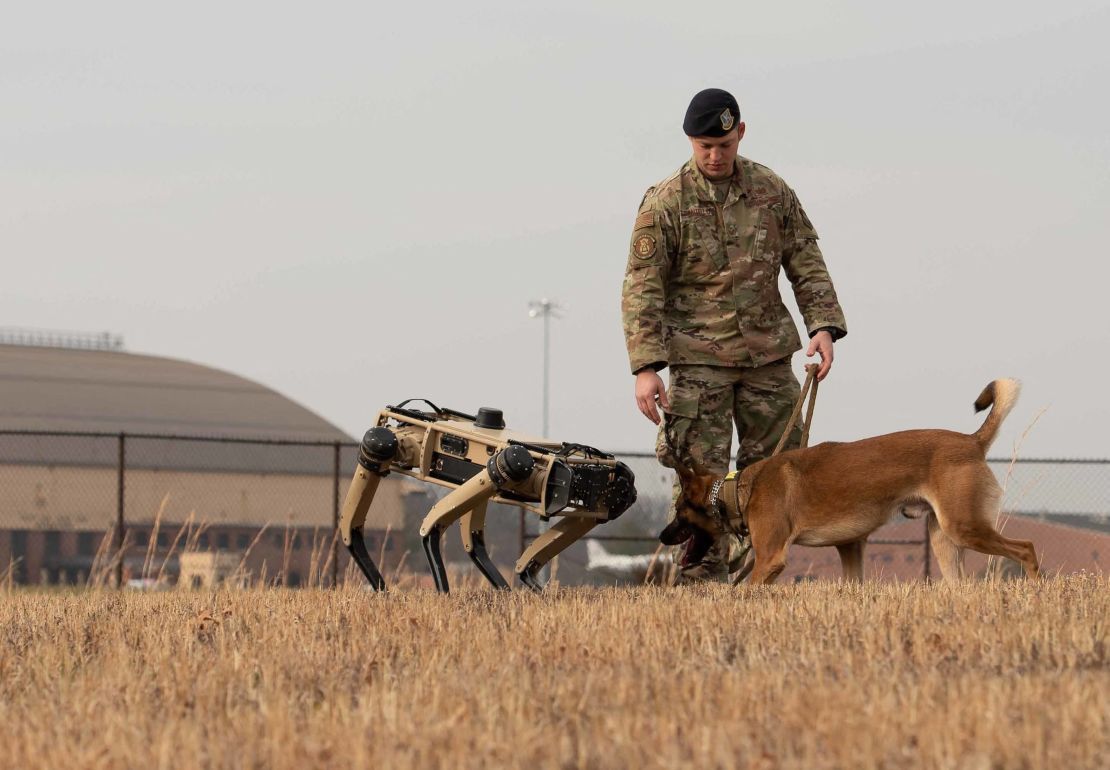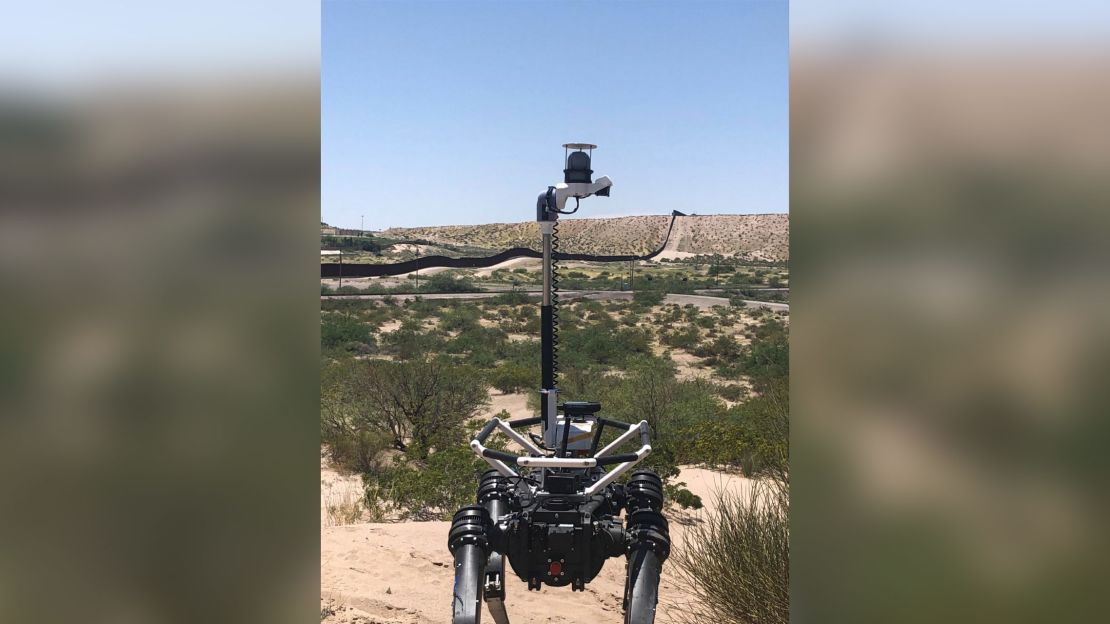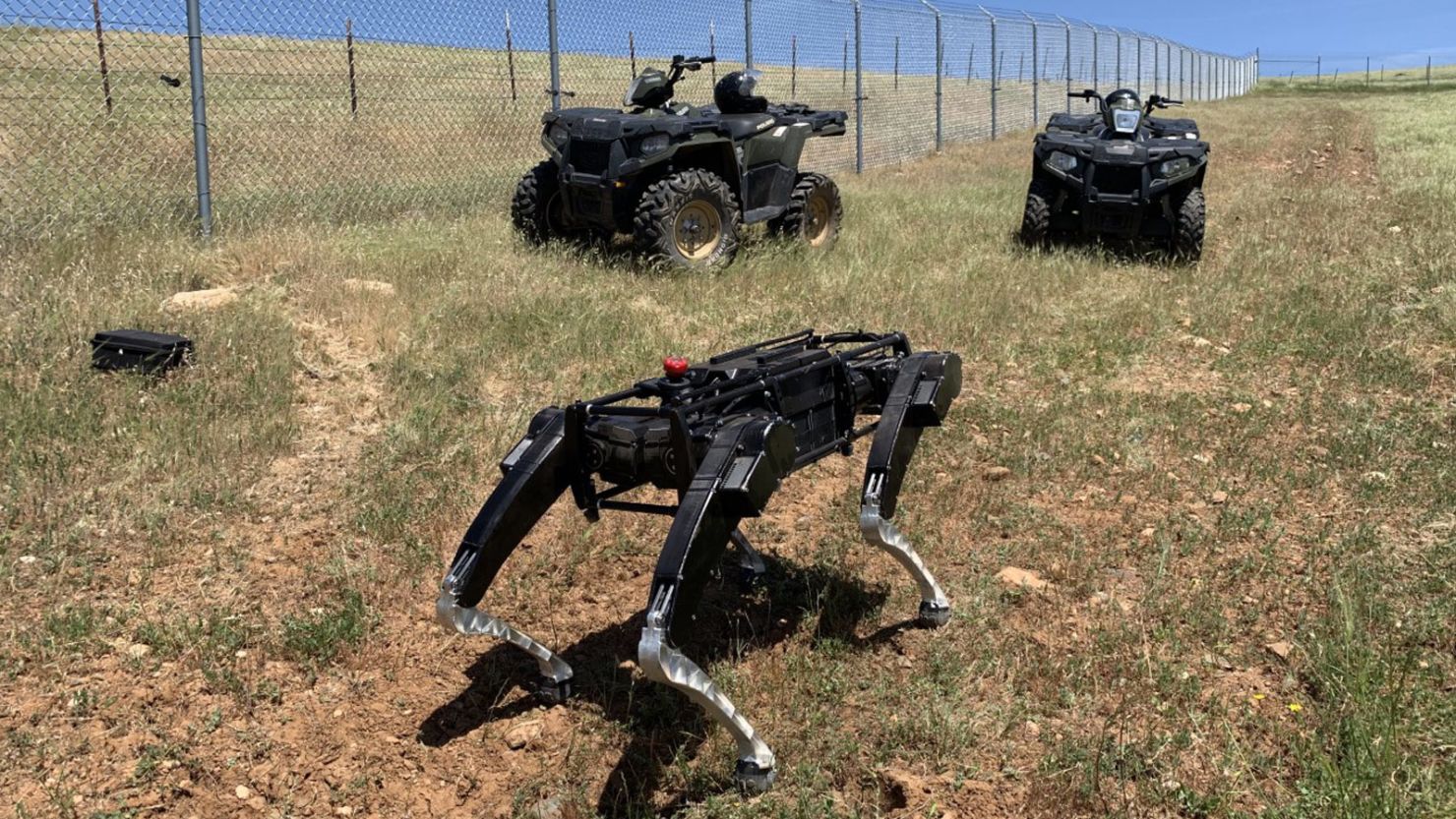The photos look like a scene out of science fiction: Robot dogs patrolling the US-Mexico border, climbing over harsh terrain to search for threats and contraband.
But these images are real.
The Department of Homeland Security recently released them as it revealed details about how it’s testing the technology.
Officials praised the robots’ potential as a “force multiplier” that could boost Border Patrol agents’ safety by reducing their exposure to life-threatening hazards. An article touting the tests on the DHS Science and Technology Directorate’s website notes that someday the dogs, officially known as Automated Ground Surveillance Vehicles, could become “a CBP agent or officer’s best friend.”
“Don’t be surprised,” it says, “if in the future we see robot ‘Fido’ out in the field, walking side-by-side with CBP personnel.”
But the details about the testing did seem to catch some people by surprise, sparking a flurry of reactions on social media comparing the images to dystopian scenes from sci-fi shows like “Black Mirror.”
“This really felt like a slap in the face,” says Vicki Gaubeca, director of the Southern Border Communities Coalition, an umbrella group that slams the initiative as an “alarming and outrageous” waste of taxpayer moneythat would be better spent developing systems to hold Border Patrol agents accountable.
Gaubeca describes herself as a lover of technology and dogs (she has five). But she says she sees nothing cute in the government’s recent descriptions of robot dogs lending a “helping paw.” For years her organization has warned that militarization along the border puts communities and migrants at risk. And this, she says, is just the latest troubling example.
“There are other technologies that they’re already using that we feel like they should cut back on, and yet they’re adding on another type of surveillance technology that’s frightening, to be honest,” Gaubeca says. “This certainly seems like it’s something that’s built for something very aggressive, like the theaters of war, rather than in a community.”
Ghost Robotics, the Philadelphia-based company that makes the robots DHS teams have been testing, says there’s nothing to be afraid of.
“We’re focused on doing the right thing. We want to do the right thing for the national security and for the country,” CEO Jiren Parikh says.
A Department of Homeland Security spokesman says the project remains in the research and development phase, with no timetable for the dogs’ deployment.
In the meantime, there are plenty of serious issues this technology is bringing to the surface.
There’s a difference between science fiction and reality
Sometimes cute and sometimes creepy, robot dogs have been captivating Americans’ imaginations for decades, long before videos of Boston Dynamics’ four-legged robots dancing to Motown and BTS started going viral.
They’ve been symbols of futuristic innovation – and ominous harbingers of what could happen if technology falls into the wrong hands.
In 1940, Westinghouse displayed a 60-pound aluminum-skinned dog at the World’s Fair named Sparko that could walk, bark and sit. In the 1960s, the Jetsons’ futuristic cartoon family briefly adopted a nuclear-powered electronic dog, Lectronimo, before deciding to donate him to the police department.
Menacing mechanical hounds hunted down fugitives in Ray Bradbury’s dystopian 1953 novel “Fahrenheit 451.” In 2017, an episode of “Black Mirror” featured terrifying robot guard dogs who chase and kill people.
But Parikh, Ghost Robotics’ CEO, says there’s a big gap between the way robot dogs are portrayed in science fiction – and sometimes skewered on social media – and the reality of the technology.
“It’s a battery-operated computer that moves around on four legs that literally stops operating in four hours. There’s no way they’re going to be taking over anything,” he says.
And, he notes, “it’s a robot that’s remotely controlled by a human in the middle.”

But still, Parikh says his company’s robots do provide a number of advantages in border zones. US Customs and Border Protection is patrolling a huge geographic area, he notes, often under harsh conditions.
“This is a good way of technology adding value,” he says, “filling in the holes.”
During testing of the 100-pound robots, different types of cameras and sensors were mounted on them, transmitting real-time data to humans operating them via laptop or hand-held remote, DHS said.
Teams first tested them on asphalt, grass and hills in Lorton, Virginia, then tested them in more realistic scenarios in El Paso, Texas, where they walked up hills, down ravines and over rocks. The El Paso testing simulated sentry duty and inspections. And exercises also included maneuvers in tight spaces, high heat and low-oxygen conditions, “situations that are especially dangerous for CBP agents and officers,” DHS said.
DHS Science & Technology program manager Brenda Long describes the dogs as a “great fit,” given CBP’s broad mission and the many risks its personnel face.
“The southern border can be an inhospitable place for man and beast, and that is exactly why a machine may excel there,” she said in the department’s press release.
Advocates at the border say they already felt under siege
Community advocates at the border have long accused the US government of militarizing the region and using excessive surveillance. And the announcement of the robot dog testing doesn’t help matters, Gaubeca says
“Border communities already feel over-surveilled, over-militarized, and yet they trot out this new technology and boast about it at a time when families are worried about how to get food on their tables and inflation,” she says. “And it completely disregards the border communities as a community. It’s like they fail to acknowledge that we’re human beings on both sides.”
For Gaubeca, it boils down to how resources are allocated.
“It’s a use of technology that creates more problems and doesn’t solve what we see as being the issue, which is how do we make this agency accountable, and how do we create a more humanitarian and efficient system at the border?” she says. “They should spend the money on something that is more humanitarian and effective, rather than intimidating.”
The Biden administration has said it wants to create a more efficient, humane, orderly system at the border, but “this completely contradicts that sentiment,” she says.
Ghost Robotics has partnered with the US Defense Department in the past. And Parikh noted he’d just gotten off the phone with Ukraine’s defense ministry before speaking with CNN this week. But he said the robot dogs on the US border aren’t part of a military effort – and any suggestion that they are is silly.

“It’s just another sensor carrier. It’s really at a distance…. It’s really for sensing around the environment. It’s not really interacting with people. That’s not what it’s made for. There’s no weapons on it,” he says. “It’s not being militarized for the border. It’s not stopping people, saying ‘don’t go here.’ It can’t do that. It’s a small robot.”
The technology, he says, is designed to keep people safe. But could it ever be used against migrants at the border?
“That’s not even come up ever,” Parikh says. “It’s not even a remote use case that’s ever discussed or talked about.”
People can’t even agree about “a basic physical wall that’s made of concrete and metal,” he says.
“Do we really think we’re going to start weaponizing robots? It’s silly to do that. I don’t think that’s in the DNA of America either,” Parikh says. “We live in a country that has so many rules and regulatory requirements in place that things like this are just remote and virtually impossible without the say of the populace.”
Parikh says Ghost Robotics regularly works with legislators as well as government agencies.
“This is not done in a vacuum …. It has to go through processes and rules. Everything we do, everything, gets questioned. Everyone has the ability to question what we’re doing.”
This isn’t just about the border
When Greg Nojeim heard about the robot dogs, his mind filled with questions. Chief among them: Has anyone studied their impact on privacy?
“The border has become a testing ground for new and intrusive surveillance technology,” says Nojeim, co-director of the security and surveillance project at the Center for Democracy and Technology.
And in many cases, he says, the law hasn’t caught up with the developing technology.
“Once the platform becomes accepted, believe me, new uses will be developed. It’s inevitable. And I don’t think we’re ready as a society to say, this use is permissible, this is not. I don’t think that legislatures are ready to say this is permissible, this use is not. … I’m concerned that the technology is getting ahead of the law.”

He says when that happens, civil liberties suffer. And that, he says, should matter to everyone, whether you live near the border or not.
As a recent Los Angeles Times opinion column noted, surveillance technologies that start out at the border often make their way into other parts of the country.
Facial recognition technology is one recent example, Nojeim says.
“That technology has now spread to some police departments, and people are finding that it doesn’t identify people as well as it could, and that people of color are being misidentified at alarming rates,” he says.
If robot dogs start patrolling the border, Nojeim says, it’s only a matter of time before they could show up in your community, too.




